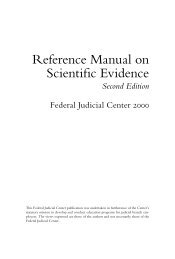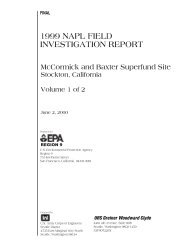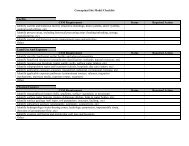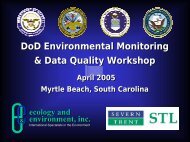Source Zone Delineation Demonstration Report - Triad Resource ...
Source Zone Delineation Demonstration Report - Triad Resource ...
Source Zone Delineation Demonstration Report - Triad Resource ...
You also want an ePaper? Increase the reach of your titles
YUMPU automatically turns print PDFs into web optimized ePapers that Google loves.
An isometric view of the upscaled and grouped soil data is shown Figure 5-13. Each of the 64 CPTlocations is represented as a vertical string of spheres, with spheres color-coded by soil type, each spherelocated at the bottom of an (upscaled) interval. The groundwater surface inferred from May 2002soundings and the ground surface are also shown in Figure 5-13. Data for both surfaces were extractedfrom ERPIMS. These two surfaces are used to vertically limit the extents of the larger, site-wide modelof vadose-zone soil architecture. The coordinate axes in the figure depict the spatial extent of the larger,site-wide model.A few comments about the limitations numerical soil models are warranted. A numerical model ofvadose zone soil architecture can only partly reflect the true complexity of the subsurface at OU 12.Moreover, the details lost in the modeling process due to the linked operations of upscaling, soil-typelumping, and modeling domain discretization may be key to understanding DNAPL migration pathwaysto groundwater. Thin, alternating beds of silty-sand and sandy-silt are very common in the raw data fromCPT borings. The model, however, does not account for architectural features thinner than the thicknessof a gridblock (2 feet, in the case of the larger soil model and 1 foot in the smaller model), such as thinlenses of clay or sand. Thus, an upscaled interval of silty sand may include a thin layer of silt or clay thatimpedes contaminant migration. Similarly, upscaled sandy-silt layers may include lenses of clean sandsthat may permit migration of contaminants. In addition, transitions between soil types are modeled asabrupt contacts, which in all likelihood do not occur in the subsurface. Smooth, gradational changesbetween soil types are also likely to occur, however, but are not reflected in the model.Finally, the sedimentary fabric of soil, imparted to the soil by depositional processes, occur on acontinuum of nested scales. Individual soil laminae are on the scale of approximately 0.10 inches or less,much too small to be correctly captured by a numerical model, because even the comparatively smalldepth increments between CPT measurements are too large to capture the detail of laminae-scale soilfabric. Yet this fabric may have a strong impact on the migration of percolating groundwater containingdissolved DNAPL. Because of the position of OU 12 on the ancestral Weber River delta deposited intoLake Bonneville, the mean dip direction of depositional laminae is likely to the west, but with somevariability due to unsteady current directions during sediment deposition. The laminae may thus drive themovement of dissolved DNAPL to the west as the contaminant makes its way vertically through thevadose zone to the water table, resulting in a lateral offset between DNAPL sources in the vadose zoneand the area of highest contaminant concentration in groundwater.5.1.2.1 Site-Wide Soil Architecture ModelThe site-wide model of vadose zone soil architecture, obtained by applying indicator kriging (Isaaks andSrivastava, 1989; Gooevaerts; 1997) to the upscaled and grouped soil-type data, is shown in isometricview in Figure 5-14. The view is looking to the northeast. Visual inspection of this limited view of themodel suggests a complex architecture of interbedded soil types consistent with a deltaic depositionalenvironment. Sand is common, but is present mainly in the upper part of the vadose zone. Silty sand isubiquitous throughout the vadose zone, and appears to be the dominant soil type. Sandy silt is common,and present mainly in the lower part of the vadose zone. Silt is uncommon.March 2003 5-19 OU 12 <strong>Demonstration</strong> <strong>Report</strong>Final










